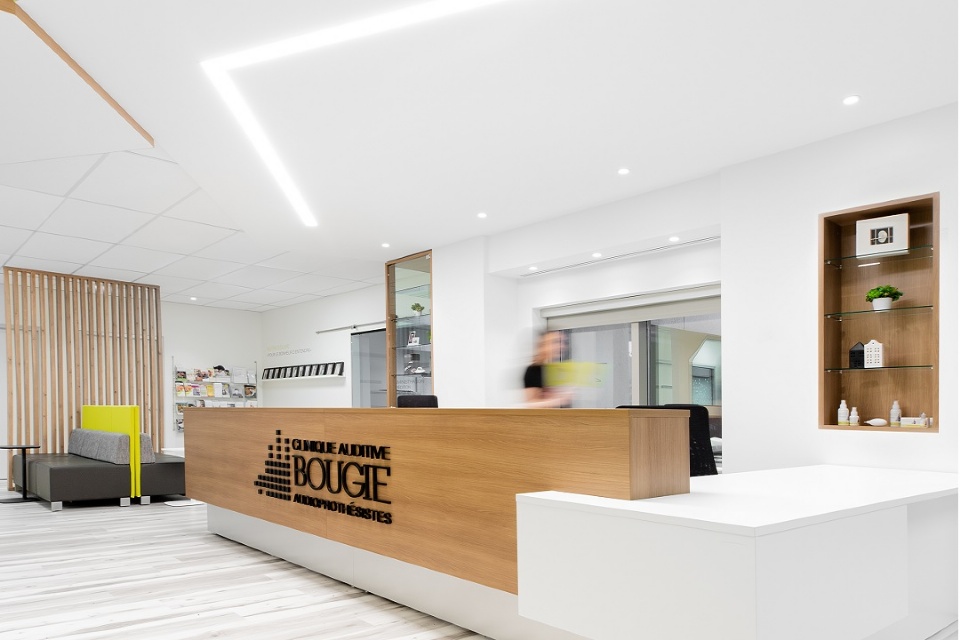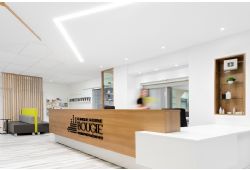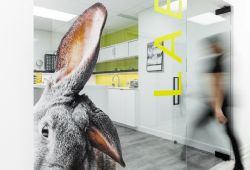A hearing screening often includes a number of different tests to
determine if a person’s hearing is normal.
The Hearing Aid Acoustician will first ask you questions about your
hearing. Do you have difficulty hearing and under what circumstances, do you
work in a noisy environment, have you ever been exposed to loud noise, is there
a history of hearing problems in your family, have you had ear surgery? He or
she will also ask other questions about your general health. This
questionnaire, called an anamnesis, is necessary to better identify the
possible sources of hearing problems.
OTOSCOPY
Next, the Hearing Aid Acoustician will examine your ears with a lighted
instrument called an otoscope. This allows him or her to see the external ear
canal, the eardrum and sometimes even part of the malleus middle ear bone which
is attached to the back of the eardrum. He will see if your ear canal is normal,
will look at its shape and check if it is obstructed by earwax, dry skin or a
foreign body.
PURE-TONE TEST AND SPEECH TEST
You will then be brought to a soundproof cabin in order to carry out the
hearing test. Using over the ear or in the ear headphones, your Hearing Aid
Acoustician will determine from your responses to instructions if you hear
sounds of medium, high and low tones at different intensities.
The hearing threshold is defined by the perception of the weakest sound
that a person hears 50<>percentage<> of the time, at the frequencies tested. The results
obtained are measured in decibels.
The other test is to have words said to you, so as to determine how you
perceive and understand speech, at an intensity that you feel is comfortable.
You will be placed turned to the side, or facing away, as to not see the Hearing
Aid Acoustician. This will make it impossible to read their lips, therefore
ensuring the validity of the test. The result of successfully repeated words is
calculated as a percentage.
Generally, a screening test ends with these two tests, the pure-tone
test and the speech test.
OTHER ADDITIONAL TESTS IF NECESSARY
This includes the bone conduction pure-tone test which allows to see the
type of hearing loss; either of the auditory nerve or of the middle ear.
Another test can be performed. This is the tympanogram, used to verify
if the middle ear is functioning normally.
RECOMMENDATION
A hearing screening lasts about 30 minutes and is painless. From the age
of 50 years old, it is highly recommended to have a hearing screening done by a
Hearing Aid Acoustician, who will then be able to counsel you and make the
proper recommendations, if necessary.

 In The Latest Issue:Latest Issue:
In The Latest Issue:Latest Issue:
- A Bittersweet Farewell
- The new Laval Aquatic Co...
- The End of an Era:
Articles
Calendar
Virtual- ANNUAL TEACHER APPRECIATION CONTEST
- APPUI LAVAL
- ARTS & CULTURE
- CAMPS
- CAR GUIDE
- CCIL
- CENTENNIAL ACADEMY
- CHARITY FUNDRAISING
- CITYTV
- COSMODÔME
- COMMUNITY CONNECTIONS
- COVER STORY
- DINA DIMITRATOS
- ÉCOLE SUPÉRIEURE DE BALLET DU QUÉBEC
- EDITORIALS
- ÉDUCALOI
- EDUCATION
- EMPLOYMENT & ENTREPRENEURSHIP
- FÊTE DE LA FAMILLE
- FÊTE DU QUARTIER SAINT-BRUNO
- FAMILIES
- FESTIVAL LAVAL LAUGHS
- FÊTE DE QUARTIER VAL-DES-BRISES
- FINANCES
- GLI CUMBARE
- GROUPE RENO-EXPERT
- HEALTH & WELL-BEING
- 30 MINUTE HIT
- ANXIETY
- CHILDREN`S HEALTH & WELLNESS
- CLOSE AID
- DENTAL WELLNESS
- EXTREME EVOLUTION SPORTS CENTRE
- FONDATION CITÉ DE LA SANTÉ
- GENERAL
- HEARING HEALTH
- MESSAGES FROM THE HEALTH AGENCY OF CANADA
- MENTAL HEALTH
- SEXUALITY
- SOCIAL INTEGRATION
- SPECIAL NEEDS
- TEENS
- THE NUTRITION CORNER
- THE NUTRITION CORNER - RECIPES
- VACATION DESTINATION
- WOMEN'S FITNESS
- WOMEN'S HEALTH
- HILTON MONTREAL/LAVAL
- HOME & GARDEN
- INTERNATIONAL WOMEN'S DAY
- JAGUAR LAVAL
- LAVAL À VÉLO
- LAVAL FAMILIES TV SHOW
- LAVAL FAMILIES MAGAZINE CARES
- LAVAL URBAN IN NATURE
- LE PARCOURS DES HÉROS
- LES PETITS GOURMETS DANS MA COUR
- LEON'S FURNITURE
- LEONARDO DA VINCI CENTRE
- LFM PREMIERES
- LIFE BALANCE
- M.P. PROFILE
- MISS EDGAR'S AND MISS CRAMP'S SCHOOL
- MISSING CHILDREN'S NETWORK
- NETFOLIE
- NORTH STAR ACADEMY LAVAL
- OUTFRONT MEDIA
- PASSION SOCCER
- PARC DE LA RIVIÈRE-DES-MILLE-ÎLES
- PÂTISSERIE ST-MARTIN
- PIZZERIA LÌOLÀ
- PLACE BELL
- PORTRAITS OF YOUR MNA'S
- ROCKET DE LAVAL
- SACRED HEART SCHOOL
- SCOTIA BANK
- SHERATON LAVAL HOTEL
- SOCIÉTÉ ALZHEIMER LAVAL
- STATION 55
- STL
- SUBARU DE LAVAL
- TECHNOLOGY
- TEDXLAVAL
- TODAY`S LAURENTIANS AND LANAUDIÈRE
- TODAY`S LAVAL
- WARNER MUSIC
- THIS ISSUE
- MOST RECENT
Magazine
The Procedure of a Hearing Screening
Articles ~e 105,7 Rythme FM 4 chemins Annual Teacher Appreciation Contest Appui Laval Arts & Culture Ballet Eddy Toussaint Camps THIS ISSUE MORE...
CONTESTS Enter our contests
CONTESTS Enter our contests
CALENDAR
Events & Activities
COMMUNITY Posts Events
PUBLICATIONS Our Magazine Family Resource Directory
LFM BUSINESS NETWORK Learn more
COUPONS Click to save!
COMMUNITY Posts Events
PUBLICATIONS Our Magazine Family Resource Directory
LFM BUSINESS NETWORK Learn more
COUPONS Click to save!
SUBSCRIPTIONS
Subscribe to the magazine
Un-Subscribe
E-NEWSLETTER Subscribe to our E-newsletter Un-Subscribe
WRITE FOR US Guidelines & Submissions
POLLS Vote today!
E-NEWSLETTER Subscribe to our E-newsletter Un-Subscribe
WRITE FOR US Guidelines & Submissions
POLLS Vote today!
ADVERTISERS
How to & Media guide
Pay your LFM invoice
SUGGESTIONS Reader's Survey Suggest a Listing
LFM About Us Our Mission Giving Back Contact Us
SUGGESTIONS Reader's Survey Suggest a Listing
LFM About Us Our Mission Giving Back Contact Us
 PICK-UP LOCATIONS
Get a copy of LFM!
PICK-UP LOCATIONS
Get a copy of LFM!
TERMS & CONDITIONS Privacy | Terms
ISSN (ONLINE) 2291-1677
ISSN (PRINT) 2291-1677
Website by ZENxDESIGN





 BY:
BY: 
Tweet
Share